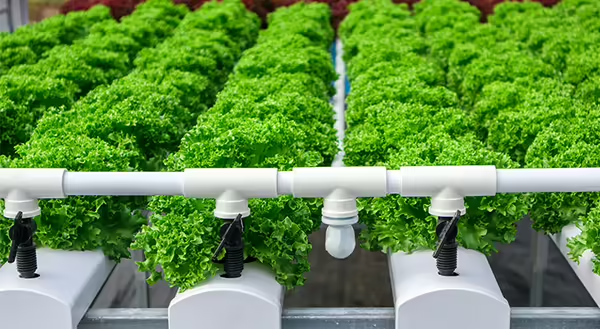
Soilless food production systems have become attractive as they present many advantages including more efficient use of the limited resources such as water that can be recirculated, growing food vertically in a small space, fewer pests, diseases, and no weeds that need to be managed, and the fact that production and harvest activities can be carried out throughout the year. Soilless production systems include hydroponics, aquaponics, aeroponics. Fruits, vegetables, and herbs tend to be the common crops grown in these systems.
Growing fresh produce in these systems should be done with awareness of the potential food safety risks involved. Some of the risks are similar to traditional outdoor production systems but others are more unique to soilless production systems. Read on to learn about common food safety risks in soilless production systems.
Water
Plants in hydroponic and aquaponic systems are continuously supplied with water in form of a nutrient solution which may be used once or recirculated/reused in the system. Depending on your system, the water may be intended to or likely to touch the harvested part of fresh produce. If the water is contaminated with harmful microorganisms, contamination can quickly spread throughout the system. Storing water for extended periods of time, failure to change the nutrient solution, and not treating water before re-circulation can compromise its microbial quality and the safety of fresh produce.
Surfaces
There are many surfaces that can come in contact with fresh produce in soilless production systems. These include workers’ hands, rafts on which produce is grown, growing media, substrates, harvesting tools and containers, gloves, tables, packing containers among others. All these food contact surfaces if not cleaned or managed properly and regularly can become a source of contamination to fresh produce.
People
To maintain continuous production year-round, more hands are needed to run the many activities that can happen in these systems within the same time. Some people may be seeding, others harvesting, some scouting, and you may have visitors. All these people can be a source of contamination if they do not wash hands properly, do not use gloves properly, if they work with produce when sick, and if they wear clothing that could have been previously contaminated.
Seeds
Untreated vegetable seeds can be contaminated with harmful microorganisms. Planting such seeds in the hydroponic or aquaponic system provides conditions favorable for the microorganisms to multiply to large numbers. Contamination introduced by seed can remain on seedlings and plants for extended periods of time, and can cross contaminate other plants, surfaces, and water within the system.
Humidity
High levels of humidity can promote growth and persistence of harmful microorganisms within the soilless production facility.
Animals and wildlife
Although rare, pests such as rodents and birds may establish themselves in soilless systems if facilities are not cleaned and maintained properly.
These and other food safety risks can be reduced by implementing Good Agricultural Practices. Whether you already have a hydroponic, aquaponic, or aeroponic operation, or you are considering starting one, this resource provides a summary of what you can do to reduce food safety risks.
References and resources
Microbial Food Safety of Hydroponic Aquaponic Systems. Video
The Occurrence of Shiga Toxin-Producing E. coli in Aquaponic and Hydroponic Systems
Agrifood Safety Produce Bites Podcast - Hydroponics and Food Safety